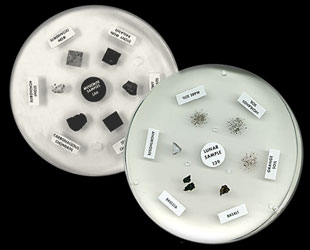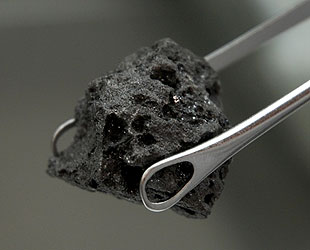December 10, 2011 — A missing moon rock educational display has led federal investigators to finding that NASA has lost track of over 500 extraterrestrial material samples over the past 40 years, a new report finds.
In the report released Thursday (Dec. 8), NASA's Office of Inspector General (OIG) concluded that the space agency "lacks sufficient controls over its loans of moon rocks and other astromaterials, which increases the risk that these unique resources may be lost."
According to the OIG, NASA's Astromaterials Acquisition and Curation Office located at the Johnson Space Center in Houston manages about 140,000 lunar samples, 18,000 meteorites and approximately 5,000 solar wind, comet and cosmic dust samples.
These samples "constitute a rare and limited resource and serve an important role for research and education," said Inspector General Paul K. Martin.
As of March, more than 26,000 of these samples were on loan around the world for scientific study, public outreach, and educational purposes.
The OIG's audit found that NASA lacks sufficient controls over these loans, which it said increases the risk that they may be lost. To that end, according to NASA records, 517 of its loaned moon rock and other samples have been lost or stolen between 1970 and June 2010.
Delaware disk gone missing
The OIG initiated its audit of NASA's loan practices after the Johnson Space Center's exhibits manager reported in June 2010 that a 6-inch (15.24-centimeter) diameter lunar sample display disk loaned to Mount Cuba Astronomical Observatory in Greenville, Delaware, had gone missing.

Examples of NASA's 455 moon rock (right) and meteorite disks loaned by the agency for classroom study and display. (NASA) |
NASA had loaned the display, which contained three lunar soil and three moon rock samples, to the observatory in 1978. The loan agreement between the two organizations had expired however, in June 2008.
As a result of an administrative oversight and the lack of a system to adequately track renewal dates for long-term loans, the exhibits manager did not contact Mount Cuba regarding the loan until February 2010.
At that time, it was learned that the employee responsible for safe-keeping the disk had died the previous year and that the observatory could not locate the sample.
As of this week, the display disk had still not been found. According to news reports, observatory officials have said that the lunar samples were returned to NASA, though the space agency has no record of receiving them.
Due to the Mount Cuba incident and concerns about other unknown losses, the OIG initiated its audit in an effort to assess NASA's controls over astromaterial loans. Per the report, the number of samples loaned to researchers has increased by more than 60 percent over the last decade.
"Additionally, NASA is planning new missions intended to collect more samples from across the solar system," the OIG report reasoned. "Accordingly, NASA's control of and accountability for these rare and valuable materials must be reliable."
Unaccounted and unused
Using NASA records, the OIG performed an inventory of astromaterial samples that were provided to 59 of the 377 United States-based scientists who were extended loans. This group represented 16 percent of the U.S. researchers with borrowed materials and 23 percent of all of NASA's astromaterial samples on loan as of the end of March.
Not only were 11 of the 59 researchers unable to account for all the samples that NASA records indicated they had received – including missing 22 meteorites and two comet samples – but 12 recipients were discovered to have died, retired, or relocated without the agency being made aware or the samples being returned.

An Apollo moon rock loaned for scientific study. (collectSPACE) |
The OIG also concluded the curation office did not ensure that the loaned samples were efficiently being used.
For example, investigators learned of one scientist who still had nine lunar samples that he had borrowed 35 years ago but which he had never conducted research. Another researcher had never conducted research on 10 meteorite samples he had kept for an average of 14 years. And still another retained 36 lunar samples for an average of 16 years after he had completed his research.
When investigators asked these individuals why they had kept the materials even though they were not using them for research purposes, some said they had requested the astromaterials in anticipation of planned research only to encounter delays such as obtaining funding. Others told the OIG it never occurred to them to return the samples after they had conducted their research.
With regard to educational displays, like the disk loaned to the Mount Cuba Astronomical Observatory, the OIG found that NASA did not have an adequate system to track its 455 astromaterial sample displays as well as the 94 moon rocks on long-term exhibit dispersed across 25 states, the District of Columbia, and 13 foreign countries.
Recommendations put into perspective
To improve controls over its loans to researchers, the OIG recommended that NASA establish detailed procedures to safeguard loaned materials, require loan agreements for all the types of materials it loans as well as strengthen its agreements already in use, and institute better methods of tracking retention periods to ensure timely use and prompt return of the samples.
The OIG also advocated NASA establish a better tracking system and annual inventory requirements for the loan of educational and public display samples.
"NASA's committed to the protection of our nation's space related artifacts, and sharing these treasures with outside researchers and the general public," spokesman Dwayne Brown said in a NASA statement.
NASA has promised to have the OIG's recommendations in place within nine months. "Actions will mostly result in changes to loan agreements and [to the] inventory control procedures," Brown said.
The agency doesn't however, consider its lunar rocks and other moon samples to be at high risk, he added.
"To put this in perspective, losses of Apollo samples have amounted to less than one hundredth of one percent of the returned samples over 40 years of intense research," Brown said.
Download the Office of Inspector General's report: NASA's Management of Moon Rocks and Other Astromaterials
